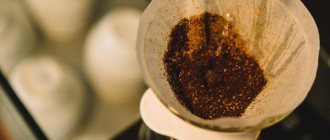So how do you properly froth milk for a latte or cappuccino? To make a latte or cappuccino, it is not enough to have coffee and milk on hand. By the way, latte and cappuccino differ from each other in the way they are prepared.
For a latte, coffee is poured into milk. For cappuccino, milk is poured into the coffee.
You also need to know how to handle these products. You can, of course, turn to the help of a miraculous coffee machine. She will do the “hard” work. And we'll talk about this later. But, if you know the rules and recommendations for proper preparation of foam, you will get aromatic and tasty drinks.
The fatter the better
And indeed it is.
The percentage of fat and protein in dairy products are important indicators. Protein affects the thickness of the foam, and fat content affects its viscousness.
Judge for yourself:
- In low-fat milk 0.5-2%. Of course the foam will work out. It will be fluffy and beautiful. But the taste will not be all right. The foam will become unsaturated and watery.
- We take a fatty product of 3%, or even higher. The foam turns out soft. The texture is thick. You just need to make an effort to beat it.
Experienced baristas in coffee shops still prefer 3.5% milk. The fact that it is difficult to whip up foam does not scare them, the main thing is the result. He won't keep you waiting. The foam will come out with excellent quality.
- If you decide to become a barista at home, start manipulating with low-fat milk, gradually increasing the percentage of fat content.
- Just never mix dairy products with different fat contents. Now manufacturers produce milk specifically for making lattes and cappuccinos. Pay attention to the labels. There is such information there.
Drying defrosted greens
Nowadays, herbs are available in supermarkets all year round, but they are not always available in the refrigerator. The lucky ones who have a summer house prudently stock up by chopping and freezing greens from the garden. When you defrost it, a liquid is formed, which is not at all needed in omelettes, baked goods or cutlets. It can be removed using a French press.
Dry defrosted greens in a French press
Preparing the foam
How to froth milk for lattes and cappuccinos, where to start?
Let's start with simple steps.
We will heat the milk to 70-75 degrees. The heating temperature can be seen without a thermometer. You will see steam and bubbles, which means the temperature has been maintained.
We warn you that the milk is not boiled. Then the texture of the product will change and there will be no point in whipping it into foam.
You can heat the milk in the microwave for 1 minute.
Soaking dried fruits
Many recipes contain recommendations: “fill the raisins with water/strong alcohol/tea and leave for XX minutes.” Then the water must be drained and, if dried fruits are used for baking, dried completely. So, you can also soak dried fruits in a French press. Just place them in a glass, fill with the required liquid and leave for the time specified in the recipe. Then lower the plunger, being careful not to crush the dried fruit, and drain the water.
Soak dried fruits in a French press
How to froth milk for a latte using a jar
Also a primitive method, but effective.
For whipping, prepare a jar with a tight lid. It will act as a real foaming agent. Show off your bartender skills and perform the same manipulations with a mock shaker.
What should be done:
- Fill the container ⅓ full with cold dairy product and screw on the lid.
- We carry out manipulations as with a shaker. 1 minute is enough.
- We monitor the increase in milk volume. It should double in size.
- Place the foam whipped in a jar, without a lid, in the microwave for 50 seconds.
Temperature will affect the foam. It will be dense and thick, but will settle.
How to make a delicious cappuccino
To prepare a delicious, aromatic cappuccino, you need to properly brew the base. It is worth choosing only high-quality coffee. The easiest way to brew it is with a coffee machine. But you can also use an ordinary Turk.
- Pour the required amount of coffee into the pot and fill it with hot water.
- Put it on the fire and heat it up. Make sure that the coffee does not start to boil. As soon as you notice that the resulting foam is rising, immediately remove the drink from the stove. After the foam has settled, repeat the entire procedure. This should be done at least three times. The more times you heat the coffee, the stronger the drink will be.
- Beat the milk foam correctly using one of the methods described above.
- Pour the coffee into a ceramic or porcelain cup.
- Using a spoon, carefully spread the milk foam onto the surface of the drink. Ideally, the ingredients should be equal. There is no need to mix them.
Cappuccino is a tasty and healthy drink. Having learned how to quickly prepare milk foam for it, you will be able to delight yourself and your loved ones with this coffee at any time.
photo: depositphotos.com/Lilun_Li
Foam using a manual frother
The devices are similar to mixers. They have oblong arms. They are very convenient both on trips and at home for making coffee. Having purchased such a device, even when going out into nature, you will not have the question of how to froth milk for lattes, cappuccinos and other drinks. Everything is at hand. Mobile devices operate on batteries.
You need to take a large container or mug, lower the device to the bottom and slowly, during its operation, lift it up. There is no need to do anything suddenly. Introduce and remove the cappuccino maker gradually. In 20 seconds you will have foam. There will be splashes, but where would we be without them?
Preparing aromatic olive oil
We love olive oil - we season salads with it, marinate fish and meat, sprinkle it on soups, stews, pasta, risotto before serving, and simply eat it with bread. For “sprinkling”, extra virgin oil infused with herbs, garlic, sun-dried tomatoes and other wonderful ingredients is great. Place a handful of fresh herbs (rosemary or thyme) in the bottom of the French press and pour in olive oil. Place the top in place, then place the French press in the refrigerator for a couple of days. Then press the plunger and add your delicious butter to bread, fish, vegetables and more!
Preparing aromatic olive oil in a French press
Coffee machines
Coffee machines have built-in cappuccino makers. They also function like automatic individual such devices.
To obtain foam you will need:
- cold dairy product;
- special dishes;
- coffee;
- cup.
What to do
- Fill the machine with coffee. There is a special compartment where coffee is poured. It's called a holder.
- Fill with water. There is also a place for water in the coffee machine.
- Turn on heating and steam supply using a special button.
- Wait until the steam becomes dry.
- Pour the dairy product into a special jug, pitcher.
- Lower the cappuccino maker to its bottom.
- Turn on steam.
- When everything is ready, the steam option will turn itself off.
If something goes wrong, the machine will tell you.
The foam, if done correctly, will be dense. Therefore, it can be decorated with grated chocolate or cocoa.
Soak and wash the cereal
Rice grains contain a lot of starch, essentially a paste. Therefore, for many dishes, rice, especially brown (brown), must be soaked. Of course, rice for pilaf should not be soaked in a French press, but for cooking morning porridge it is quite possible, especially if you need to cook no more than 2 servings. First rinse the rice. Pour the rice into a French press glass. Lower the plunger and repeat this step one more time if desired. Drain the water. The cereal will be washed. Remove the piston, pour in hot water (50-60 °C) and leave for 30-60 minutes. Drain the water, rinse the cereal again and prepare the porridge.
Soak and rinse rice in a French press
Proper frothing for cappuccino
In order to understand how to froth milk for latte, cappuccino and whether it is frothed correctly, you need to look at the foam.
If it is whipped according to the rules, then all its characteristics will be present in it.
She will have:
- Homogeneous structure.
- No bubbles.
- Sweetish taste.
- First, you need to work on your whisking technique. Don't take large quantities at once. Try whipping small portions with the means at hand. If you use coffee machines, be sure to read the instructions.
- Don't overheat the milk. The dairy product will acquire a specific taste.
- After mastering the knowledge of how to froth milk for lattes and cappuccinos, take up art latte. That is, try to apply patterns on the foam.
Milk and microfoam (coffee encyclopedia article)
When customers order a latte at a coffee shop, they usually ask the barista to mix 2 ingredients in their coffee cup: espresso and fresh steamed milk. Well-prepared milk (with an even distribution of milk microfoam) can transform a mediocre latte into a great coffee drink, but in reality, it is a rather delicate and multi-step process.
Firstly (this step should never be neglected) - wipe the milk frothing steam valve with a wet towel, or wash it in water before you start working with milk. Next, pour cold milk into a clean pitcher; milk must be poured in sufficient quantities - the pitcher should be one-third or half full. It is best to take a pitcher that is an order of magnitude larger than the amount of drink you want to prepare, for example: in order to prepare 8 ounces of drink, you need to take a pitcher of at least 12 ounces. This will help to thoroughly froth the milk and aerate it, and will ensure that the resulting frothed milk is sufficient to completely cover the steam tap.
Immerse the tip of the steam wand into the milk, just below the surface of the milk. I usually use the line connecting the steam tap spout to the steam wand as an indicator - to properly immerse the steam tap into the pitcher - I align this strip with the surface of the milk, when this is achieved - you can froth!
Turn on the steam valve at full power, and immediately begin to slowly lower the pitcher in order to saturate the milk with air, while leaving the tip of the steam valve under the surface of the milk, so that a characteristic foaming sound is heard. This sound will be your indicator that the milk frothing process is going well, it should not be too loud or squealing - it is a light, pleasant, intermittent sound of air permeating the drink. When the aeration process has begun, you need to stir the milk so that a milk funnel appears in the pitcher. As you stir, the milk will heat up, and your circular movements will begin to break the large bubbles that appear in it during the aeration process into smaller ones, which will create good conditions for the formation of microfoam. If the milk does not foam, it may splash out of the pitcher, which can lead to unpleasant consequences.
When you feel that the milk is almost frothed, touch the bottom of the pitcher with your free hand (the one with which you turned on the steam tap) to check how much the milk has warmed up during your actions.
The aeration process must be completed before the milk heats up to more than 40°C, since the air bubbles that appear in it at higher temperatures cease to be evenly divided into smaller ones through the “milk whirl” artificially created in the pitcher. This is the moment when you just begin to feel the warmth on your hand. Once the milk reaches this temperature (the pitcher will be barely warm to the touch), you have successfully completed the aeration process and can safely move on to the next stage.
Place the nozzle of the steam tap into the pitcher so that it is below the surface of the milk, but at the same time does not touch the bottom or walls of the vessel. Now the milk needs to be heated to its final temperature (55-65°C, depending on which recipes are used for which drinks in your coffee shop). At this temperature, the milk will be too hot to rest your hand on the pitcher, but not too hot to lightly touch the bottom or sides of the pitcher with your hand.
You can change the angle of the pitcher relative to the steam valve so as to create a funnel of vortex movement in it. This way you can stir the foam that has formed closer to the surface throughout the entire space of the milk in the pitcher. When the milk becomes too hot to hold the pitcher, turn off the steam tap pressure. Place the milk on the counter, wipe the steam tap with a special cloth and blow it out one more time.
If a few large bubbles float to the surface of the milk at this stage, lightly tap the pitcher on the surface of the counter to remove them. Swirl the milk a few times in a circular motion and it's ready to be added to the cup to give your customer the latte of their dreams!
Choosing milk for coffee
Milk is 88% water. But it contains 3 types of substances, the quantity of which determines the taste of the drink, the quality and stability of the milk foam:
- fats;
- proteins;
- carbohydrates.
The less fat in milk, the easier it is to whip it. But fats give the foam an oiliness, similar to cream. Skim milk foam tastes dry and the bubbles are too large. The optimal milk fat content is considered to be in the range of 2.5–3.2%. With higher fat content, milk is harder to froth, but the foam has a truly “creamy” texture. Milk with a fat content of less than 2% tastes too watery and should not be used for making milk-coffee drinks.
The elasticity of milk foam depends on the presence of proteins. At temperatures above +75 °C, proteins decompose, so boiled milk is not suitable for making milk and coffee cocktails.
Carbohydrates (mostly lactose) give milk its natural sweetness. If you want to make the cocktail a little sweeter without adding sugar, you can use lactose-free milk: in it, lactose is split into glucose and galactose. Glucose is approximately 5 times sweeter than lactose.
Pitcher with milk frothed
When choosing milk for coffee, baristas recommend adhering to the rule: the more intense the taste of coffee, the more fatty milk suits it. Less fatty milk (2.5%) goes well with coffee, which has a delicate taste.
High-fat milk masks the bitter taste of Robusta or Liberica well. It is not for nothing that in Indonesia, where a lot of Liberica is grown, it is customary to drink coffee with concentrated (unsweetened condensed) milk. Pasteurized milk with a fat content of 3.8–4%, as well as baked milk, goes well with Robusta.
Step-by-step whipping instructions
The whipping process consists of the following steps:
- Pour dairy products into pitcher. It should be 1 cm less than the height of the beginning of the spout.
- Place the end of the cappuccino maker at an angle of 45° near the wall of the pitcher. It should point slightly away from the center of the milk jug. Depth up to 1 cm.
- When the end of the cappuccino maker is immersed in milk, you can turn on the machine to supply steam. The pitcher is usually held by the bottom to monitor the temperature.
- Hold the cappuccino maker so that the milk rotates in a whirlwind and a hiss is heard.
- The cappuccino maker is gradually lowered deeper to maintain the desired sound.
- Monitor the temperature of the bottom of the pitcher. If the bottom is warm, you need to proceed to the second phase.
- Submerge the nozzle lower so that the hissing disappears, but the contents continue to rotate. Typically occurs 1 cm above the bottom of the pitcher.
- Warm until you can hold the pitcher by the handle without any problems. The temperature should not be higher than +75°.
- Turn off the steam supply and remove the nozzle.
- To ensure that the foam has a uniform consistency, you need to shake the pitcher with light movements and periodically tap the pitcher on the table.
Whipping equipment - cappuccino maker and pitcher
Before you begin the process of preparing a coffee drink, you need to prepare the equipment. To whip the ingredients, the coffee machine must be equipped with a special tube that releases steam. The barista must also prepare a clean pitcher (jag).
Cappuccinatore – devices for preparing milk foam used in espresso-based drinks. The device must be connected to the steam wand on the coffee machine. Today there are a large number of devices of different shapes, dimensions, methods of supplying steam and functions performed. The most common attachment is the Panarello cappuccino maker. There are two types of cappuccino makers:
- steam – spray principle;
- mechanical - the principle of torsion of the rims.
The pitcher is primarily a metal vessel for whipping. They can also be made of ceramics, plastic and glass. The material must have good thermal conductivity properties, since in order to froth milk, its temperature must be controlled. Also, the material must have a neutral chemical composition. A poor quality pitcher can greatly affect the taste of your coffee drink.











